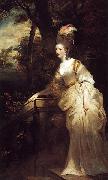Wholesale Oil Painting No Minimum |
|||||||||||
|
|
|||||||||||

|
|||||||||||
|
|
|
||||||||
Sir Joshua ReynoldsBritish 1723-1792 Sir Joshua Reynolds Locations Reynolds was born in Plympton, Devon, on 16 July 1723. As one of eleven children, and the son of the village school-master, Reynolds was restricted to a formal education provided by his father. He exhibited a natural curiosity and, as a boy, came under the influence of Zachariah Mudge, whose Platonistic philosophy stayed with him all his life. Showing an early interest in art, Reynolds was apprenticed in 1740 to the fashionable portrait painter Thomas Hudson, with whom he remained until 1743. From 1749 to 1752, he spent over two years in Italy, where he studied the Old Masters and acquired a taste for the "Grand Style". Unfortunately, whilst in Rome, Reynolds suffered a severe cold which left him partially deaf and, as a result, he began to carry a small ear trumpet with which he is often pictured. From 1753 until the end of his life he lived in London, his talents gaining recognition soon after his arrival in France. Reynolds worked long hours in his studio, rarely taking a holiday. He was both gregarious and keenly intellectual, with a great number of friends from London's intelligentsia, numbered amongst whom were Dr Samuel Johnson, Oliver Goldsmith, Edmund Burke, Giuseppe Baretti, Henry Thrale, David Garrick and fellow artist Angelica Kauffmann. Because of his popularity as a portrait painter, Reynolds enjoyed constant interaction with the wealthy and famous men and women of the day, and it was he who first brought together the famous figures of "The" Club. With his rival Thomas Gainsborough, Reynolds was the dominant English portraitist of 'the Age of Johnson'. It is said that in his long life he painted as many as three thousand portraits. In 1789 he lost the sight of his left eye, which finally forced him into retirement. In 1791 James Boswell dedicated his Life of Samuel Johnson to Reynolds. Reynolds died on 23 February 1792 in his house in Leicester Fields, London. He is buried in St. Paul's Cathedral. |
||||||||
|
|
||||||||
Portrait of Georgiana, Duchess of Devonshire
Portrait of Georgiana, Duchess of Devonshire Painting ID:: 75995 |
1775-1776
Oil on canvas
237 ?? 145 cm (93.3 ?? 57.1 in)
cjr 1775-1776 Oil on canvas 237 ?? 145 cm (93.3 ?? 57.1 in) cjr |
|||||||
|
|
||||||||
|
Thomas Gainsborough 1727-1788 British Thomas Gainsborough Locations English painter, draughtsman and printmaker. He was the contemporary and rival of Joshua Reynolds, who honoured him on 10 December 1788 with a valedictory Discourse (pubd London, 1789), in which he stated: If ever this nation should produce genius sufficient to acquire to us the honourable distinction of an English School, the name of Gainsborough will be transmitted to posterity, in the history of Art, among the very first of that rising name. He went on to consider Gainsborough portraits, landscapes and fancy pictures within the Old Master tradition, against which, in his view, modern painting had always to match itself. Reynolds was acknowledging a general opinion that Gainsborough was one of the most significant painters of their generation. Less ambitious than Reynolds in his portraits, he nevertheless painted with elegance and virtuosity. He founded his landscape manner largely on the study of northern European artists and developed a very beautiful and often poignant imagery of the British countryside. By the mid-1760s he was making formal allusions to a wide range of previous art, from Rubens and Watteau to, eventually, Claude and Titian. He was as various in his drawings and was among the first to take up the new printmaking techniques of aquatint and soft-ground etching. Because his friend, the musician and painter William Jackson (1730-1803), claimed that Gainsborough detested reading, there has been a tendency to deny him any literacy. He was, nevertheless, as his surviving letters show, verbally adept, extremely witty and highly cultured. He loved music and performed well. He was a person of rapidly changing moods, humorous, brilliant and witty. At the time of his death he was expanding the range of his art, having lived through one of the more complex and creative phases in the history of British painting. He painted with unmatched skill and bravura; while giving the impression of a kind of holy innocence, he was among the most artistically learned and sophisticated painters of his generation. It has been usual to consider his career in terms of the rivalry with Reynolds that was acknowledged by their contemporaries; while Reynolds maintained an intellectual and academic ideal of art, Gainsborough grounded his imagery on contemporary life, maintaining an aesthetic outlook previously given its most powerful expression by William Hogarth. His portraits, landscapes and subject pictures are only now coming to be studied in all their complexity; having previously been viewed as being isolated from the social, philosophical and ideological currents of their time, they have yet to be fully related to them. It is clear, however, that his landscapes and rural pieces, and some of his portraits, were as significant as Reynolds acknowledged them to be in 1788. Portrait of Georgiana, Duchess of Devonshire 1783(1783) Oil on canvas cjr |
||||||||
|
|
||||||||
|
Prev Next
|
||||||||
|
|
||||||||
|
Related Paintings to Thomas Gainsborough :. |
||||||||
|
|
||||||||
|
CONTACT US |

